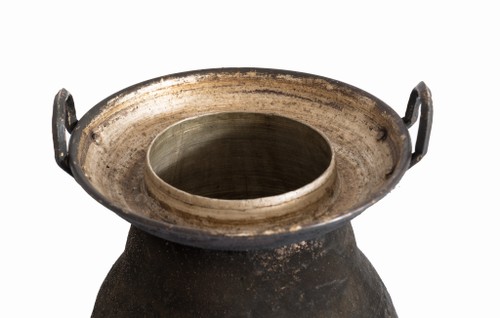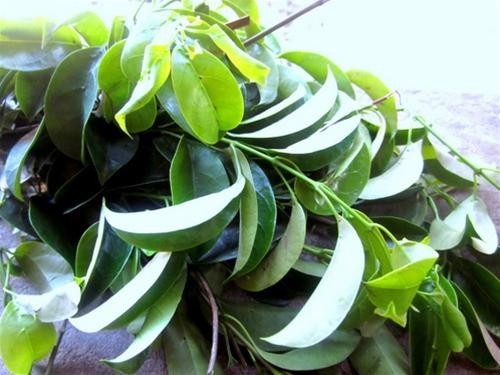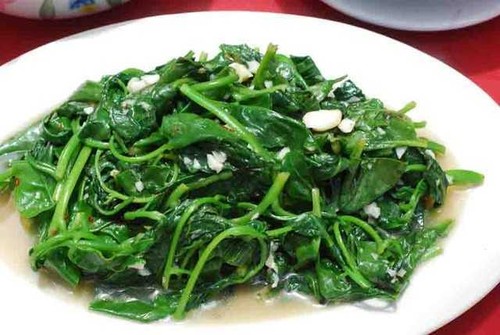Thai people use different kinds of vegetables in different seasons. Steamed vegetables is a dish made from several kinds of vegetables. Vì Thị Áng of Mường Sang commune, said: "The first kind is a sour vegetable because of its sour taste. Thai people only eat its blossoms and young leaves. The flower buds taste the best. The sour trees grow along the streams and in the forests. There are only two or three trees in this area."
Pennywort, an indispensible part of the dish, makes it still more fragrant. It’s a kind of herb that’s good for people with kidney diseases. Thai people crush it up, mix it with sugar, and drink the juice. Cilantro, a key ingredient of any vegetable mixture dish, is very fragrant after being steamed. Another wild vegetable used in a Thai meals is called “sắng”, which can not grow well without the rain. Its sweet taste makes it suitable for making soup or vegetable mixtures. Locals use “sắng” a variant of MSG. Other kinds include fish-bone vegetable or chrysanthemum which grow on the edge of the fields.
Before being steamed, the vegetables are cleaned once again. The old stems and damaged leaves are removed. The short stems are separated so that the vegetables will not become tangled when they’re stirred. The youngest parts are kept to make a delicious, sweet, and soft dish. After being cleaned, the vegetables are steamed in a steamer. Áng elaborated: "The dish does not taste good if we use too much lard or cooking oil. Steaming them is the best way to serve the dish but if we do not have much time, we can boil them and take them out quickly. Steaming at low heat will make the vegetables turn yellow and unattractive. If the heat is too high, the vegetables will become pulpy."
The steamer, also called “hày khẩu”, is a special cooking tool of the Thai people. Unlike the steamers of the Kinh people – the earthen and alluminum steamers, “hày khẩu” has two layers, the lower – “ninh đồng” is for containing water and the upper one – “hày khẩu” is made of wood and has the shape of a cylinder. Making a “hày khẩu”, chiseled from the trunk of a tree, takes a lot of time and effort and not everyone can make a beautiful and durable one.
 Thai people in Son La province use "hày khẩu" and "ninh đồng" to cook vegetables (Photo: Trieu Chien) Thai people in Son La province use "hày khẩu" and "ninh đồng" to cook vegetables (Photo: Trieu Chien) |
“Hày khẩu” is accompanied by a “ninh đồng” whose bottom is as big as a pot but its mouth is smaller. On the mouth of the pot, there’s a curved flaring part for funneling water. Thanks to this segment, “hày khẩu” and “ninh đồng” is closely connected. The steam, thus, gets exclusively to the food. To know whether the food is done or not, the cook often pinches a bud. If it’s soft, they will take “hày khẩu” out of the stove. The steamed vegetables are then taken out to a tray before they are seasoned. Áng explained: "After taking the vegetables out, we give the mixture a pinch of salt, dried chilli and some ground and roasted“mắc khén”, a mixture of salt and some other secret spices. We also add some sliced fresh cilantro and ground ginger. We often include ginger in our daily meals. We think that ginger improves immune resistance, and helps to treat colds and rheumatism."
The seasoning and mixing should be attended to carefully so that the vegetables are well absorbed in the spices without getting pulpy. Noteably, the dish should be seasoned with a moderate amount of spice or else the mixture will be too salty, spicy, or bland.
 "Lồm" vegetable - a folk remedy (Photo: mangtay.net) "Lồm" vegetable - a folk remedy (Photo: mangtay.net) |
“Lồm”, so-called “giang”, is a variety of creeper. Its leaves taste sour and cool, so the locals often use them for antipyretic dishes. It’s also a folk remedy for indigestion, stomachache, and arthropathy. The stem of the creeper is a remedy for urinary stones, chronic kidney disease, rheumatism or swelling. “Lồm” leaves are usually stir-fried with buffalo meat because their sourness reduces the unpleasant smell of buffalo meat and makes it more delicious when it is well absorbed with the spices. The leaves can be cleaned for a salad or for soup. After taking the leaves home, they clean them and remove old leaves. While working with the leaves, they simmer bones for broth. When the bones are well-cooked, the leaves are put into the pot. The recipe for this dish is very simple. However, the cook should take attend the stove well to prevent the leaves from getting pulpy.
Another favorite dish of the Thai people is “tầm bóp” vegetables stir-fried with garlic. They peel the garlic, crush it, fry it then put vegetables in for stir-frying. “Tầm bóp”, also called “lồng đèn” (which means lantern), is found in the forest, along the edges of the fields or on the grassplots. The plant, which tastes slightly bitter, can be used to treat stomachache, diabetes, and some other diseases. Dishes from this kind of vegetable are easily made and good for health.
 Stir-fried “tầm bóp” with garlic (Photo: baomoi.com) Stir-fried “tầm bóp” with garlic (Photo: baomoi.com) |
Vì Văn Lít from Mường Sang commune, said: "We often have stir-fried “tầm bóp” with garlic. These vegetables are safe as they are not protected by chemicals. It’s bitter when you first chew it but it’s sweet afterwards. The soup made from this kind of vegetable is very sweet. Our ancestors told us which kind of vegetables is edible and which is not. There’s a kind of plant which looks like “tầm bóp” but it’s toxic. Also, mushrooms that attract many mosquitoes and germs are normally edible. If not, they’re toxic."
After returning from the forest, the Thai people often take an interesting ingredient home: rattan shoots. This kind of shoot is found in any season but is rarer than the bamboo shoot. Rattan is a climbing plant which may be dozens of meters long. The top of the plant has a mantle of thorns. To get the shoot, the people have to pull the plant down. Thai people say that the shoot is good for people with abdominal distension and intoxicated people. The hard covers of the shoot are removed exposing the white part inside. This part can be boiled, grilled, cooked as a soup or eaten raw. Dishes from this kind of shoot are normally served with “chẳm chéo” which is a mixture of sliced lemon leaves, salt, dried chilli, and ground “mắc khén”. In the Thai language, “chẳm” means “seasoning mix”. Like people in the low land, the Thai people prepare various kinds of seasoning mix for different dishes by combining several spices in separate mixtures. Mr. Lít continued: "This kind of shoot is like bamboo shoot, but it’s found in high mountains or rocky hills. It takes us half a day to collect enough shoots for the dish. It’s served with a seasoning mix, whose ingredients include “mắc khén”, the special spice of the northwest. During war time, the people here were too poor to buy rice, so they had to eat wild leaves when they evacuated in the forests. People in the past did not have meat as we do today. The ethnic people here have been very familiar with the dishes made from wild leaves."
The dishes of the Thai people have the unforgettable bitterness of wild leaves. The common dishes are served with pork grilled over smoking shell, sticky rice and rice cooked in bamboo tubes.